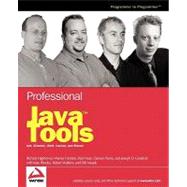
Warner Onstine is a founder and CTO of Interface Guru, a leading Web Usability firm where he consults on back-end technology issues with specific emphasis on how technology and usability work together to present the user with an easy-to-use interface. Warner also runs his own custom development shop, Sandcast Software, which focuses on community and team-oriented software.
Warner got his first computer, a TI-99 4/A, when he was 9 and almost immediately attempted to program a game in Basic on it, which did not work. He stubbornly refuses to get rid of that machine though, along with his trusty NeXT Turbo MonoStation, upon which he got his first taste of Objective-C. This eventually led to Java, skipping right over C++.
His strong community background soon led him to open source, where he has had the chance to meet and interact with several incredible individuals from Jakarta and other open source communities. This also has helped him to keep an open eye on the trends that will soon shape the new landscape—one of his specialties.
Another skill he has is in assisting companies with making the right choices at the right time, utilizing XP, in-depth knowledge of their subject area, and the currently available tools germane to their problem. Warner is also a co-founder and President of the Tucson Java Users Group, which he helped form in 2001, which keeps him rather busy at times. Previously, Warner worked at eBlox, Inc. (a Web development company), Intalio, Inc. (a bay-area Business Process Management Server company), and the University of Arizona Main Library on the Digital Library Team.
Paul Visan is an expert J2EE developer. He serves as a Principal Software Engineer for eBlox, Inc, where he finds that open source tools are invaluable to his work. Paul is a proud Romanian native, now living in the heart of Tucson Arizona. He is a regular contributor to IBM’s developerWorks, for which he has written a series of tutorials on Java Web Services. Paul would like to thank Andrew Barton, Nicholas Lesiecki, Tim Ryan, and Victoria McSherry for helping with this book.
Damon Payne currently works as the Microsoft Business Group manager for Centare Group, Ltd. in Milwaukee, WI. Damon is very passionate about open source technology in the Java and Microsoft .NET worlds. His other professional interests include Mobile development, data persistence patterns, and product development. When not programming or speaking Damon enjoys raising his wonderful daughter, Brooke, home theater, and music.
Joseph D. Gradecki is a software engineer at Comprehensive Software Solutions, where he works on their SABIL product, a enterprise-level securities processing system. He has built numerous dynamic, enterprise applications using Java, AspectJ, servlets, JSPs, Resin, MySQL, BroadVision, XML, and more. He is the author of Mastering JXTA and the coauthor of MySQL and Java Developer's Guide (with Mark Matthews and Jim Cole). Joeholds Bachelors and Masters degrees in Computer Science and is currently pursuing a Ph.D.
Kate Rhodes is a self-taught programmer, serial entrepreneur, and occasional musician with a Japanese nickname and an unstoppable urge to learn new things, solve new problems, and write open source apps. She’s got too many pets, too many projects, and too little time. If she could afford an army of programming minions she’d have one.
She’s ranked better than most and worse than some. She’s worked in impressive places you’ve possibly heard of and unimpressive places you’ve never heard of. She’s done some stuff she’s very proud of and some she isn’t. And so long as life keeps offering up interesting new challenges for her to learn from, she’s happy. If you’re overcome with curiosity you can always see what Kate and her wife are up to at www.masukomi.org.
Robert Watkins is a Brisbane, Australia-based software developer of nine years’ experience. He’s been called a programmer, a software engineer, an architect, and a few other things (many unprintable), but mostly ignores the titles and does what he has to do. These days he is mostly working in J2EE and related technologies, and is a passionate advocate of agile development techniques. When not working, he spends most of his time with his wife and twin children, and when he gets a chance, he takes time out to read Terry Pratchett novels. Robert is also one of the developers on the CruiseControl project.
Erik Meade is an employee of Wells Fargo, who attended XPImmersionTwo, interviewed at XPImmersionThree, coached at XPImmersionFour, and hung out on the evenings of XPImmersionFive. He is the edior of junit.org and an evangelist of JUnit, Ant, CruiseControl, HttpUnit, Tomcat, and open source in general. He is also a contributor to JUnitPerf.
|
|||
| PART I: AUTOMATED BUILDING AND CONTINUOUS INTEGRATION. | |||
|
|||
|
|||
|
|||
|
|||
|
|||
|
|||
|
|||
|
|||
|
|||
|
|||
| PART II: AUTOMATED JAVA TESTING. | |||
|
|||
|
|||
|
|||
| PART III: AUTOMATED J2EE TESTING. | |||
|
|||
|
|||
|
|||
|
|||
|
|||
|
|||
|
|||
|
|||
|
|||
|
|||
|
|||
| PART IV: AUTOMATED SWING TESTING. | |||
|
|||
|
|||
|
|||
| PART V: CONTINUOUS INTEGRATION AND PROJECT MANAGEMENT. | |||
|
|||
|
|||
|
|||
|
|||
|
|||
|
|||
|
|||
|
|||
The New copy of this book will include any supplemental materials advertised. Please check the title of the book to determine if it should include any access cards, study guides, lab manuals, CDs, etc.
The Used, Rental and eBook copies of this book are not guaranteed to include any supplemental materials. Typically, only the book itself is included. This is true even if the title states it includes any access cards, study guides, lab manuals, CDs, etc.